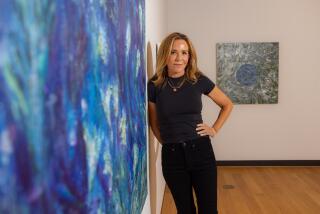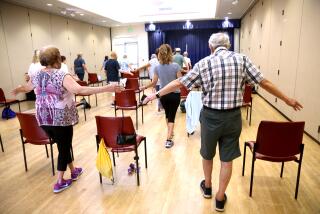Yes, There Is a Fountain of Youth, Flushed Out by Creative Expression
- Share via
In his best-selling book, “Anatomy of an Illness,” Norman Cousins revealed the secret medication that cellist Pablo Casals took in his 80s to combat the symptoms of arthritis and emphysema. His unorthodox prescription for health consisted of liberal doses of Bach, Brahms and Mozart played on the piano first thing in the morning after a night’s sleep and again in the afternoon after a nap.
This daily ritual, Cousins observed, transformed a badly stooped man with swollen fingers into an animated man whose body was no longer stiff and shrunken, but supple and graceful.
“Creativity for Pablo Casals was the source of his own cortisone,” Cousins wrote. “It is doubtful whether any anti-inflammatory medication he would have taken would have been as powerful or as safe as the substances produced by the interaction of his mind and body.”
Like Casals, thousands of older adults each day paint and write their way to increased health. Recent studies conducted by social scientist E. Paul Torrance, professor emeritus of educational psychology at the University of Georgia, give quantitative support to the intuitive premise that these artistic activities are innately healing.
Boon to Condition
In 1977 and 1978, he tested 200 men and women ages 65 though 85 who were enrolled in painting and drawing classes. After 1 year of classes, 96% reported “feeling more alive and fresh,” 71% said they were more active than before and 59% reported not being sick as often.
“Creative expression, such as painting, music and writing, helps people reduce stress, release pent-up emotions and grow in self-esteem,” said Betsy Horton, Wellness Center coordinator at Grossmont Hospital in San Diego, who also teaches “Technologies for Creating,” a course on awakening creativity.
“When inner feelings take shape on the canvas or in a poem, we gain insight in our emotional state. Without the therapeutic objectivity that art gives us, our feelings remain hidden and can potentially develop into psychosomatic illness.”
Not Limited to the Aesthetic
Creativity need not be limited to our usual aesthetic associations, Horton said. As the art of bringing something new into being, it can include learning a new language, taking a course in some intellectual discipline, watching a sunset after hiking in the country or playing games with grandchildren without regard for one’s “adult image.”
These activities fight “psycho-sclerosis,” the hardening of attitudes that many people identify with old age.
“Based on childlike qualities, such as wonder, curiosity, playfulness and imagination, creativity enables people to meet life’s challenges with fresh solutions, untried possibilities,” Horton said. “When we reject the cultural stereotype that equates old age with inflexibility, we find among seniors a great potential for self-expression that just needs encouragement and the proper environmental support to blossom.”
When these ingredients are liberally provided, why do so may health benefits accrue?
According to Susan Shepherd, a social worker with Socare (Seniors Only Care), a geriatric assessment program in San Diego, creative activity heals the body by relaxing the central nervous system, much like yoga and relaxation therapy.
For example, as the mind focuses on painting by blocking out stimuli in the environment, the body relaxes in a state of peaceful--but alert--awareness. And the mind becomes naturally cheerful and positive.
Grounded in Present Moment
This interaction of mind and body, besides reducing stress and anxiety, awakens the senses and grounds the person in the present moment.
“With a peaceful, focused mind,” Shepherd said, “you can meet whatever challenge comes up in the next moment with equanimity and poise. This centering is particularly helpful to older patients who might be fragmented because of illnesses, doctor visits and complex insurance systems they’re dealing with.”
In fact, Socare psychiatrist Enid Rockwell added, in some cases creativity may even increase people’s resistance to disease. This premise, however, remains to be proven by further scientific research.
Besides its potential for adding years to life, Rockwell sees creative endeavors as a means of “reality testing,” envisioning and trying new roles when one is in transition from one state of life to another. In dealing with retirement, for instance, one may role-play new situations in advance, use journal entries to explore finding a new purpose in life or give expression to grief over leaving the productive years of middle age behind.
So potent is the coping ability inherent in creative expression that Margaret Simpson, a Kentucky social worker who had two radical mastectomies for cancer in 1959, used poetry to anesthetize herself from intense pain.
“Under cobalt, linear acceleration and during chemotherapy treatments, I found that recitation of remembered poetry and the writing of my own poetry had been powerful anesthetizers,” she wrote in her book, “Coping with Cancer.”
“Without fear, I did not develop many of the side effects experienced by many other cancer patients, such as nausea and the pain produced by fear.”
To receive such health benefits, older adults have many options. They can develop their talent in structured programs at community colleges or universities, at senior centers or social day-care centers. If they have disabilities, such as Parkinson’s or Alzheimer’s diseases, they can enroll in adult day-care programs.
Adult day care stimulates older adults to retain their highest functional level, according to Linda Cota-Robles, director of the Center for Aging at San Diego’s VillaView Hospital. Word games sharpen mental faculties, while crafts groups, music and movement classes and sing-along sessions not only keep people physically dexterous, but emotionally integrated.
“Without creative involvement in life, people tend to have more problems with mobility and overall mental and physical functioning,” she said. “Arts and crafts exercises are not pastimes like basket weaving but crucial activities that stimulate the neuromuscular system and tell the body, ‘Stay healthy, keep going.’ ”
If people don’t choose structured programs to develop their creativity, the loss of a spouse or the onset of an illness may challenge them to encounter life with greater flexibility and spunk, said Dr. Stephen Shuchter, director of UC San Diego’s Gifford Mental Health Clinic.
Widows who may have grown “set in their ways” suddenly may find themselves forced by circumstances to release old patterns and to risk new activities, such as checking the oil in their cars or dealing with the complexities of banking and medical insurance--activities requiring creative adaptation to life’s challenges.
To stimulate creativity, Shuchter recommended:
- Take on new challenges, especially things you have avoided because of some perceived limit (“I can’t do it”).
- Try activities you have always wanted to try but postponed because of practical necessity. Take up the violin or cello and give expression to the musical vocation you gave up 40 years ago to raise a family.
- Assess what truly gives you pleasure, then actively pursue it. If law or political science always intrigued you, study it wholeheartedly.
More to Read
Sign up for Essential California
The most important California stories and recommendations in your inbox every morning.
You may occasionally receive promotional content from the Los Angeles Times.










